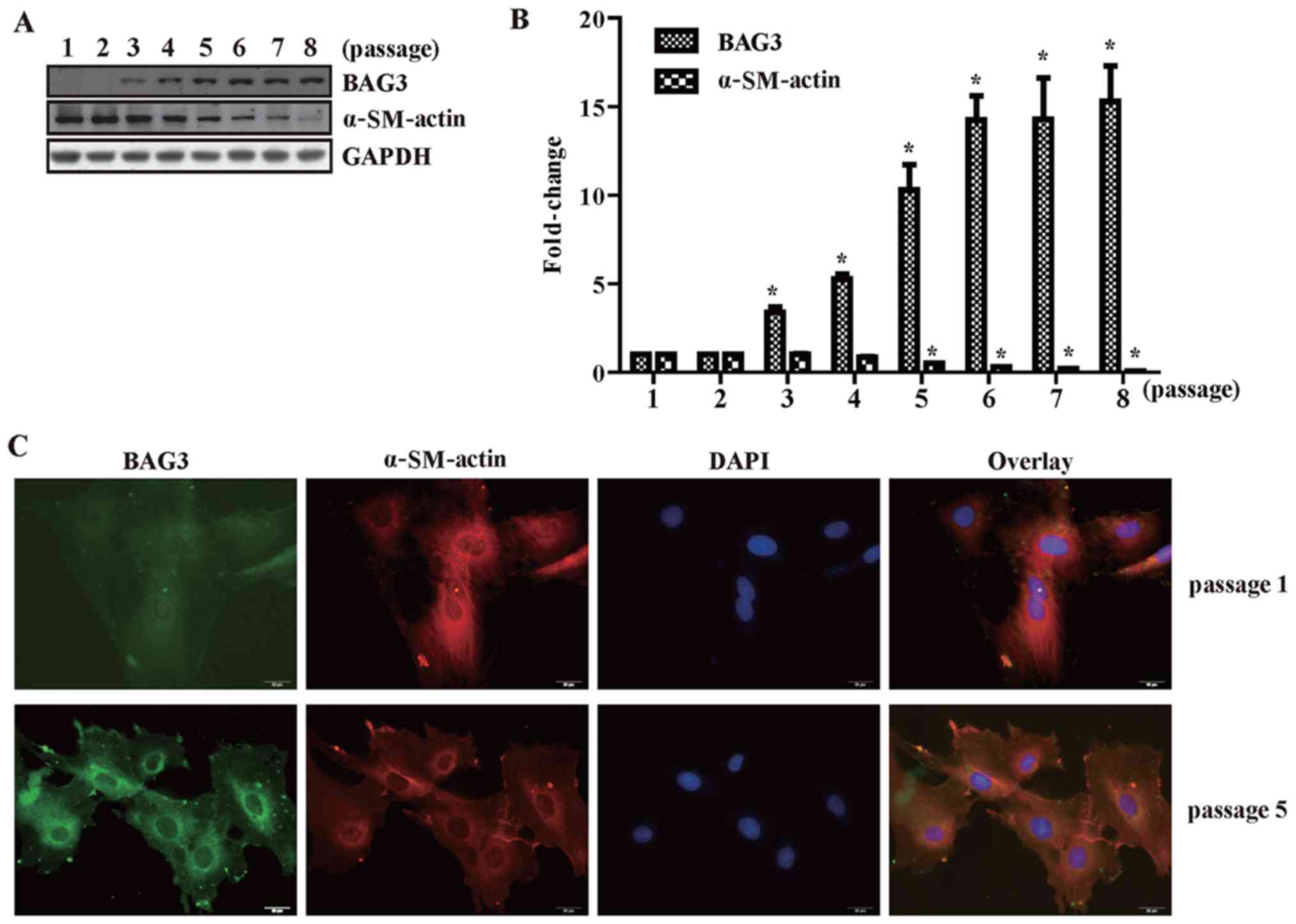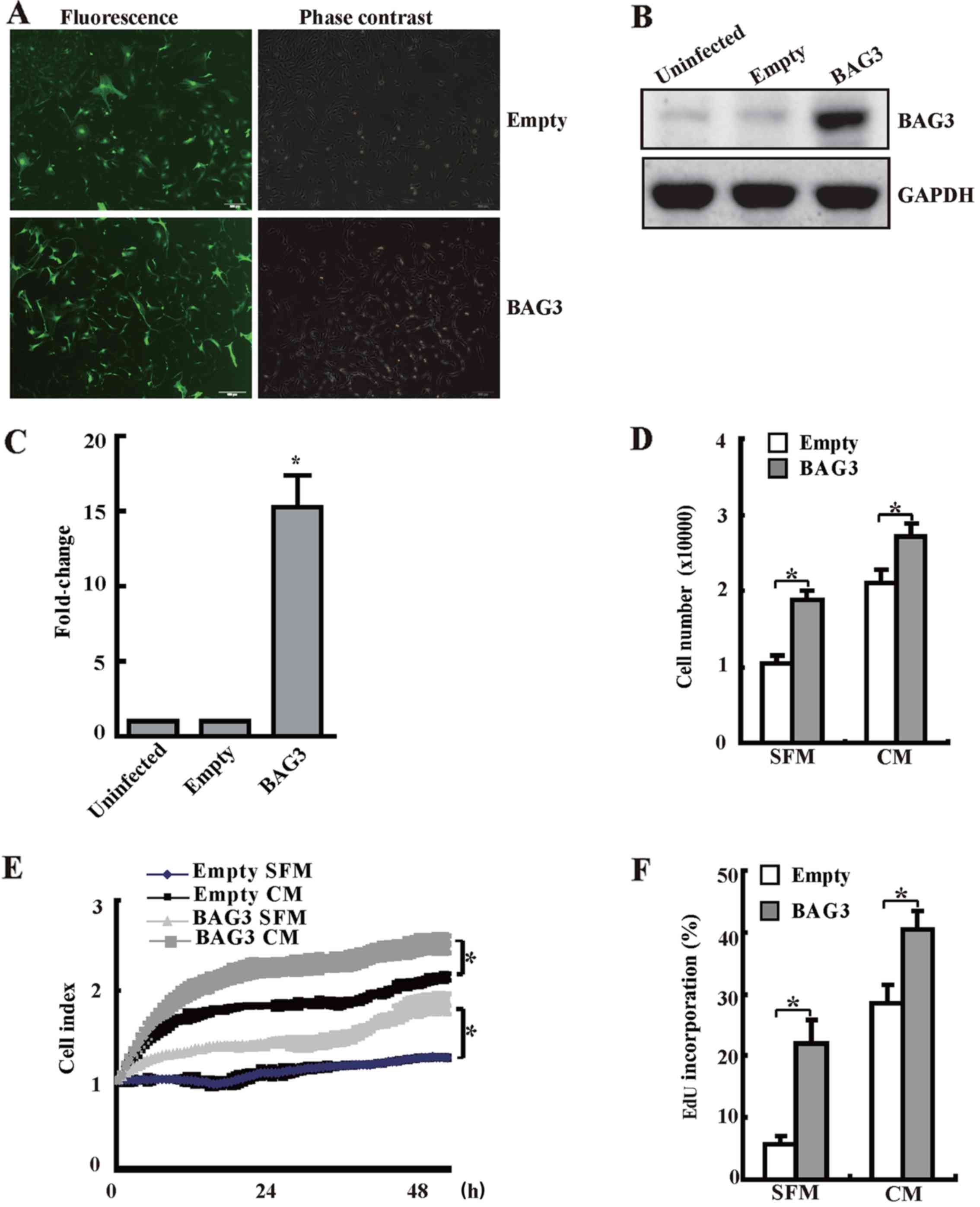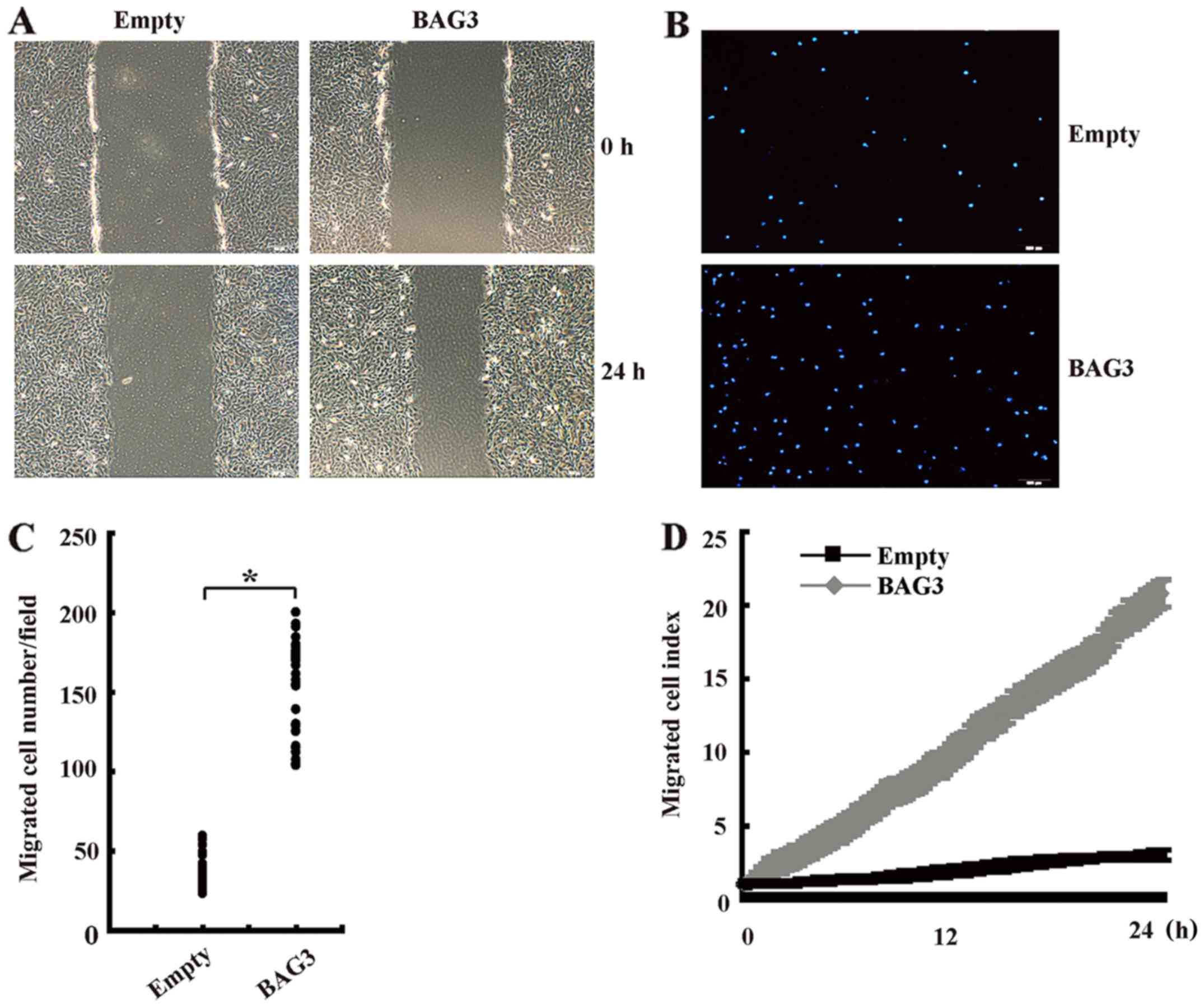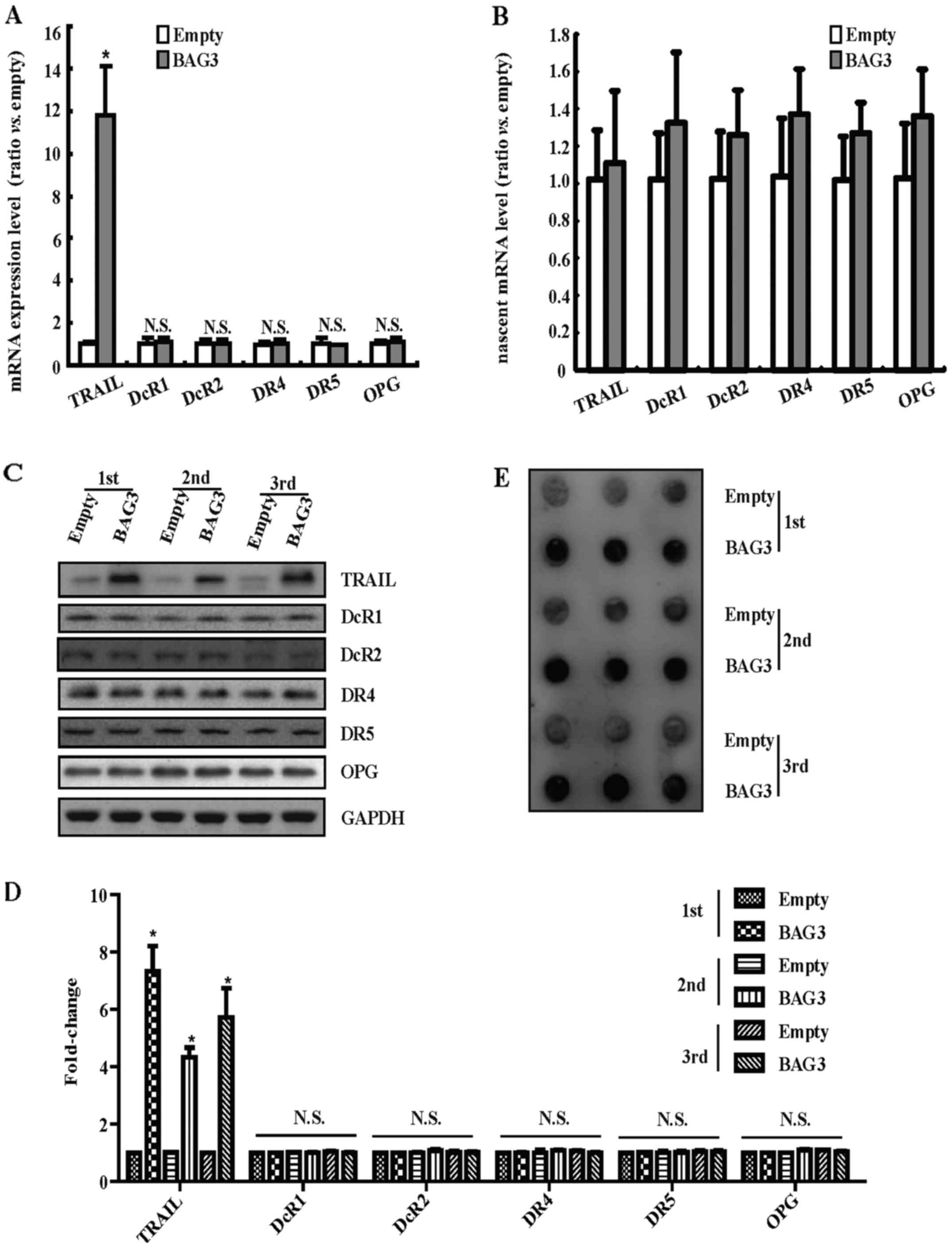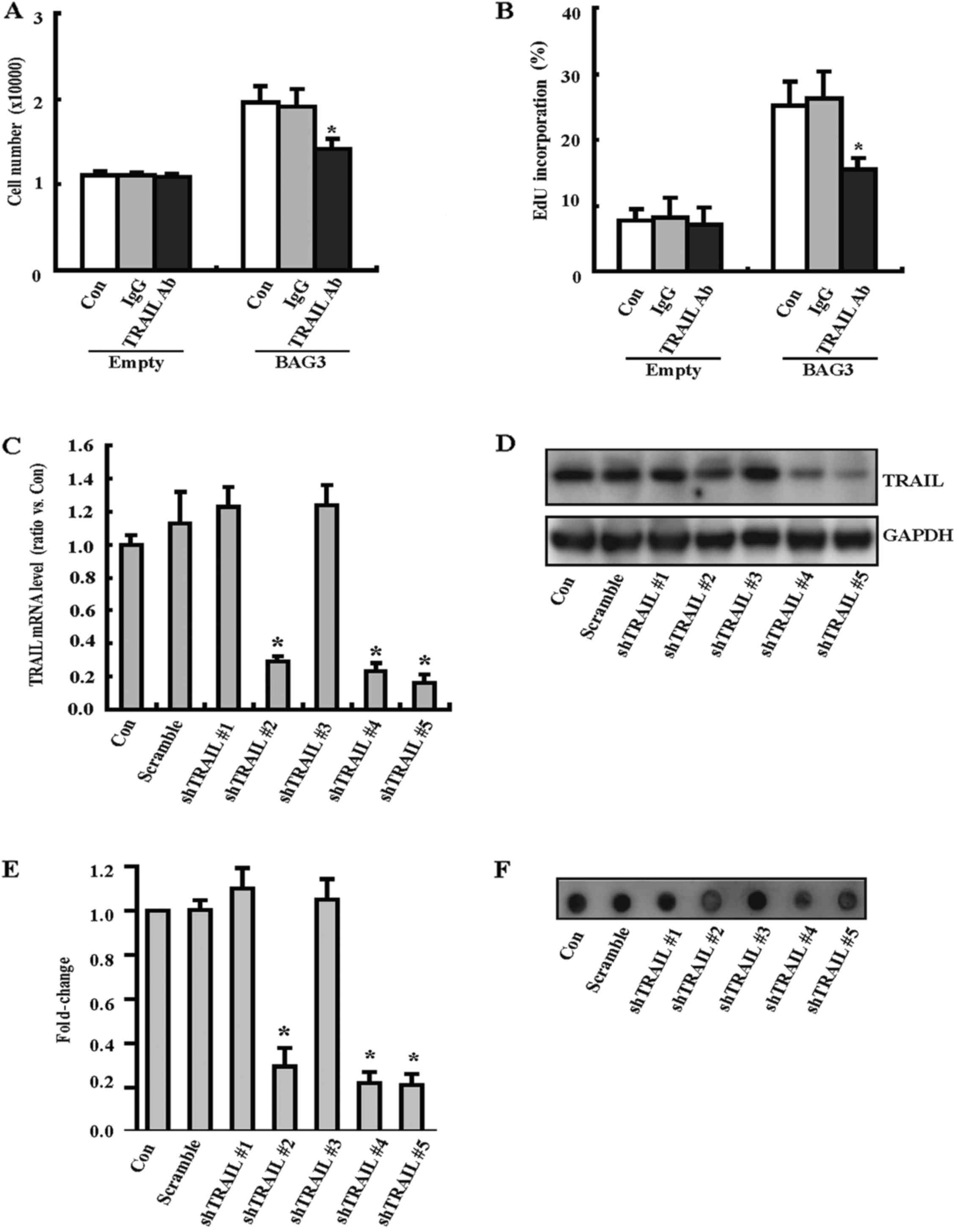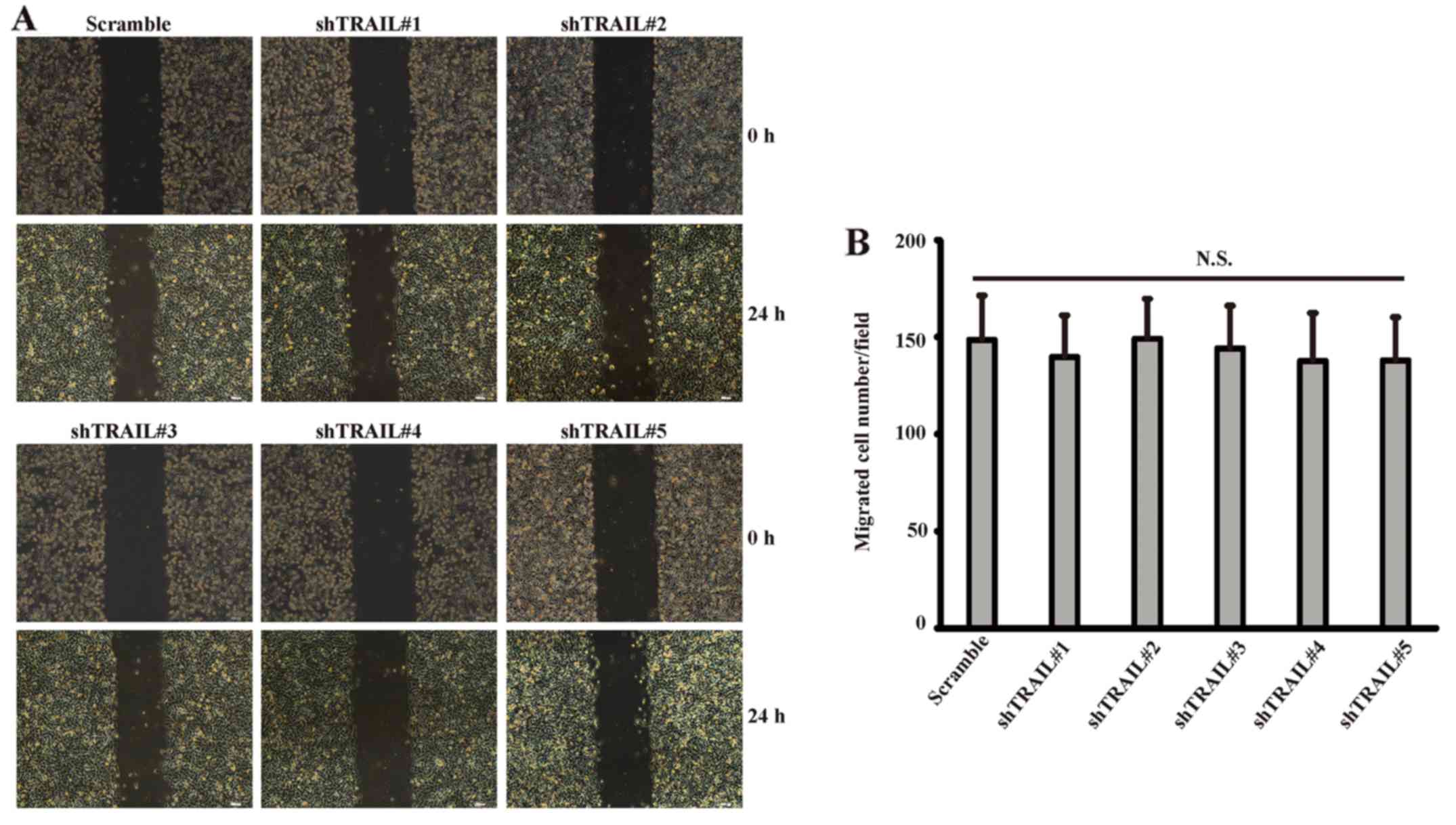BAG3 promotes the phenotypic transformation of primary rat vascular smooth muscle cells via TRAIL
- Authors:
- Published online on: February 14, 2018 https://doi.org/10.3892/ijmm.2018.3493
- Pages: 2917-2926
Abstract
Introduction
The formation of atherosclerotic plaque is the pathological basis of coronary heart disease (CHD), vascular complication of hypertension and restenosis after angioplasty or bypass (1). The phenotypic transition of vascular smooth muscle cells (VSMCs) plays an important role in the formation and development of atherosclerosis (AS) (1). Under normal physiological condition, the mature VSMCs show differentiated phenotype, and mainly perform contractile function and the proliferation and migration are inefficient (2). They can synthezise and express some contractile markers specific to smooth muscle, including α-SMA, SM22α and α-SM-actin (3). Unlike most mature cells such as skeletal muscle cells and cardiomyocytes, VSMCs are not terminally differentiated cells and have remarkable plasticity (2,4). VSMCs were able to convert from the differentiated phenotype to dedifferentiated phenotype which can ensure rapid adaptation to various environmental stimuli (4). The dedifferentiated phenotype was characterized by the increased ability of proliferation/migration and the reduction of contractile ability (5). Though an increasing number of studies have reported various factors and mechanisms that may control VSMCs phenotype modulation, further efforts are still required to elucidate the detailed mechanism and biological importance of the phenotype modulation of VSMCs.
Bcl-2-associated athanogene 3 (BAG3) is a member of BAG family and plays an important role in diverse cellular behaviors including cell apoptosis, autophagy, proliferation, adhesion, migration and differentiation (6–9). Accumulating evidence indicates that BAG3 is associated with various cardiovascular diseases such as myocardial hypertrophy, dilated cardiomyopathy, Takotsubo cardiomyopathy and chronic heart failure (10–13). Normal tissues seldom express BAG3, except for cardiomyocytes and skeletal muscle cells, but its expression is induced upon exposure to various stressful stimuli (14). However, there is no previous investigation of BAG3 function in the phenotype modulation of VSMCs.
Tumor necrosis factor-related apoptosis inducing ligand (TRAIL), a member of tumor necrosis factor (TNF) family, belongs to type II membrane protein (15). TRAIL can interact with five different receptors, DR4 (TRAIL-R1), DR45 (TRAIL-R2), DcR1 (TRAIL-R3), DcR2 (TRAIL-R4), and OPG. After binding with death receptors DR4 and DR5, TRAIL can trigger cell apoptosis. Due to lack of the intracellular death domain, DcR1 and DcR2 are considered as decoy receptors to protect normal cells from apoptosis. OPG can work in bone tissue metabolism (16–18). Chiappetta et al reported that BAG3 could downmodulate the apoptotic response to TRAIL in human neoplastic thyroid cells (19). However, the relationship between BAG3 and TRAIL and their effects the proliferation and migration in VSMCs are rarely reported.
The present study analyzed BAG3 expression in VSMCs and investigated its role in the phenotypic transition of VSMCs. Moreover, we determined whether BAG3 could promote the proliferation and migration of VSMCs via TRAIL.
Materials and methods
Ethics statement
Animals used in our study were treated in accordance with the National Institutes of Health (NIH) Guide for the Care and Use of Laboratory Animals. The procedures was in accordance with the ethical standards of the Committee on Animal Experimentation of China Medical University (project identification code, SCXK-2013-0001).
Materials
Real-Time PCR system was purchased from Applied Biosystems (Foster City, CA, USA). Click-iT Nascent RNA Capture kit was purchased from Invitrogen Life Technologies (Carlsbad, CA, USA). Western blotting related equipment was purchased from Invitrogen Life Technologies. EdU Alexa Fluor 555 Imaging kit was purchased from Invitrogen Life Technologies™. The real-time cell analyzer (RTCA) xCELLigence system was purchased from ACEA Biosciences (San Diego, CA, USA). Fluorescence microscope (CKX41-F32FL) was purchased from Olympus (Tokyo, Japan). MicroChemi 4.2 was purchased from DNR Bio-Imaging Systems, Ltd. (Jerusalem, Israel). Smart Blotter SB-10 was purchased from Wealtech (Reno, NV, USA). Transwell related equipment was purchased from BD Biosciences (Franklin Lakes, NJ, USA). Microplate reader was purchased from Bio-Rad Laboratories, Inc. (Hercules, CA, USA). Antibodies for α-SM-actin, BAG3, DcR1, DcR2, DR4, DR5, OPG and glyceraldehyde 3-phosphate dehydrogenase (GAPDH) were all purchased from Santa Cruz Biotechnology, Inc. (Santa Cruz, CA, USA). Lentiviral vectors were purchased from GeneChem (Shanghai, China).
Isolation and culture of primary VSMCs
Neonatal rats 1–2 days old were sacrificed by cervical dislocation and disinfected with 75% alcohol, then moved into the clean bench. The thoracic aorta was excised and the inner/outer layers of blood vessel were removed. And then primary neonatal rat VSMCs were isolated as previous described by us (20). VSMCs were cultured in complete medium including 10% fetal bovine serum (FBS) and penicillin-streptomycin (100 U/ml-100 µg/ml) at 37°C, 5% CO2, and with humidified atmosphere as previously described (20,21). Media were changed every other day. After primary cells reached 80–90% confluence, 0.25% trypsin was added into the culture plate for digestion. Thirty seconds later, serum-containing medium was used to terminate the digestion. Subsequently, a part of the cells were moved into a new culture dish. After attachment, cells were incubated with complete medium, which was passage 2 of VSMCs. With these methods, cells between passages 1–8 were obtained and applied for the next experiments.
Transduction of BAG3 and TRAIL to primary rat VSMCs using lentiviral vectors
The lentiviral plasmids labelled by green fluorescent protein (GFP) were used in the knockdown experiments, which contained short hairpin RNA (shRNA) against rat TRAIL or control shRNA. There were five shRNA oligonucleotides specific for rat TRAIL, i.e., TRAIL #1, 2, 3, 4 and 5. Furthermore, the lentiviral plasmids labelled by GFP containing BAG3 cDNA were used in the overexpression experiments. Transfection of shRNA oligonucleotide was performed with Lipofectamine 2000 (Invitrogen Life Technologies) according to the manufacturer's recommendations. Transduced cells were cultured for 2 days and then proteins were extracted and analyzed by western blotting.
Cell proliferation assay
Cells were seeded into 6-well plates at a density of 1×104 cells/well and cultured with 10% FBS. The medium was changed every 2 days or as necessary. Cell number at the indicated time-point was determined by counting using a haemocytometer.
Immunofluorescence
Cells were fixed with 4% paraformaldehyde for 15 min at room temperature. After washed with phosphate-buffered saline (PBS) three times, cells were permeabilized with 0.25% Triton X-100 in PBS for 5 min. After blocked with 1% BSA, cells were incubated with first antibody (1:200) in PBS overnight at 4°C. After washed with PBS three times, cells were incubated with secondary antibody for 1 h in the dark. After washed with PBS three times, cells were incubated with 0.1% DAPI for 5 min at room temperature. Finally cells were analyzed under a fluorescent microscope.
Western blotting
Western blotting was performed as our previous studies indicated (20,22). Briefly, cells were solubilized in a lysis buffer for 30 min, and then total protein concentrations were measured by a BCA Protein Assay kit. After heat denaturation, the samples were analyzed on a 12 or 14% Tris-glycine gradient gel, and then transferred to PVDF membranes and blocked with 5% non-fat milk in Tris-buffered saline (TBS) for 1.5 h at the room temperature. The membranes were incubated with primary antibody overnight at 4°C. After washing three times with TBS, the membranes were incubated with secondary antibodies for 1.5 h at room temperature. After washing steps, immunoreactive binding were detected with enhanced chemiluminescence (ECL) (Amersham Biosciences, Piscataway, NJ, USA). The band intensity was quantified using ImageJ 1.47 software and GAPDH as a control.
Dot blot
The secreted proteins in the media were extracted and quantified similarly to those in western blotting. Then 100 µl sample volume was blotted onto a nitrocellulose membrane and blocked with 5% non-fat milk for 1.5 h at the room temperature. Subsequently, the membranes were incubated with first antibody at 1:1,000 dilution overnight at 4°C. After washing three times with TBS, the membranes were incubated with secondary antibodies for 1 h at room temperature. After washing three times with TBS, immunoreactive binding was detected with ECL detection reagent with MicroChemi 4.2.
MTT assay
MTT assay was used to determined cell viability. VSMCs were seeded in a 96-well plate at a density of 4×103 cells/well. After cultured 48 h, cells were incubated with MTT solution (final concentration, 5 mg/ml) for 4 h at 37°C. Then the culture media containing MTT were removed and replaced with 100 µl DMSO. Then the plate was gently rotated on a linear and orbital shaker for 5 min to completely dissolve the precipitation. The absorbance was measured with microplate reader at 570 nm. The percentage of cell viability was calculated according to the following formula: cell viability (%) = optical density (OD) of the treatment group/OD of the control group ×100%.
RTCA proliferation assays
To analyze the cell proliferation continuously over time, growth curve assays were performed in RTCA in quadruplicate with the xCELLigence system according to the methods described (23). Briefly, 5,000 cells/well were seeded in RTCA E-plates. After the chambers were set up, the RTCA E-plate was put into xCELLigence instrument at 37°C, 5% CO2 incubator and cell index was recorded every 15 min. The shift of the electrical impedance was expressed as the cell index, which was a parameter of cell viability.
EdU incorporation analysis
As described by our previous studies (20,24) and the manufacturer's instructions, DNA synthesis rate in VSMCs was determined by EdU incorporation analysis using Click-iT™ EdU Alexa Fluor 555 Imaging kit. Briefly, the cells were incubated with EdU-labeling solution for 8 h at 37°C, and then fixed with 4% cold formaldehyde for 30 min at room temperature. After permeabilization with 1% Triton X-100, the cells were reacted with Click-iT reaction cocktails (Invitrogen Life Technologies) for 30 min. Subsequently, the DNA contents of the cells were stained with Hoechst 33342 for 30 min. Finally, EdU-labeled cells were counted using ImageJ 1.47 software and normalized to the total number of Hoechst-stained cells. At least 500 cells in each experiment were counted, EdU-positive cells were expressed as a percentage of the total cells.
Wound healing assay
Cells at 80–90% confluence were wounded with a 200 µl pipette tip and incubated with SFM or CM for 24 h. Multiple views of the leading edge of the scratch were photographed under a microscope at 0 and 24 h. The experiments were performed three times independently.
Transwell migration assay
For the Transwell migration assay (8-µm pores; BD Biosciences), cells were seeded at density of 2×106 cells in the upper chamber. The lower chamber was filled with SFM or CM. After cultured for 24 h, cells on the upper chamber were removed by gentle abrasion with a cotton bud, and the cells on the lower chamber were fixed and stained with Hoechst 33342. Three experiments were performed independently. The cells that passed through the filter were photographed under fluorescence microscope with ultraviolet light. Hoechst-labeled cells in five representative microscopic fields were counted using ImageJ 1.47 software.
RNA extraction and real-time (RT)-PCR
The total RNA was extracted by Qiagen RNeasy Mini kit (Qiagen, Berlin, Germany). After the determination of concentration, the synthesis of cDNA was performed. With the primer design software we synthesized the sense and antisense primers of each fragment: TRAIL sense primer, 5′-tcgtgatcttcacagtgctcctgcagtc-3′ and antisense primer, 5′-tctaacgagctgacggagttgccacttg-3′; DcR1 sense primer, 5′-gattacaccaacgcttccaac-3′ and antisense primer, 5′-gctggtgttcattgtctcttc-3′; DcR2 sense primer, 5′-ttcttgcctgctatgtacag-3′ and antisense primer, 5′-aggatggtggtcactgtctc-3′; DR4 sense primer, 5′-gagtacatctaggtgcgttcctgg-3′ and antisense primer, 5′-agagccccacactttgctgg-3′; DR5 sense primer, 5′-tagcactcactggaatgacc-3′ and antisense primer, 5′-gtggacacattcgatgtcac-3′; OPG sense primer, 5′-gcctaactggcttagtgtcttg-3′ and antisense primer, 5′-ccaatgtgccgctgcagctg-3′; GAPDH sense primer, 5′-cgtcccgtagacaaaatggt-3′ and anti-sense primer, 5′-ttgatgttagtggggtctcg-3′. Quantitative RT-PCR was run and analyzed with the 7500 RT-PCR system (Applied Biosystems). Results were normalized against those of GAPDH and presented as arbitrary unit.
Label and capture nascent RNA
Click-iT Nascent RNA Capture kit was used to detect newly synthesized RNA according to the manufacturer's instructions. 5-Ethymyl uridine (EU) is an alkyne-modified uridine analog and it could be efficiently and naturally incorporated into the nascent RNA. Cells were incubated in 0.2 mM of EU for 4 h and total RNA labeled with EU was isolated using TRIzol reagent (Invitrogen Life Technologies). Then EU-labeled RNA was biotinylated in a Click-iT reaction buffer with 0.5 mM of biotin azide and subsequently captured on streptavidin magnetic beads.
Statistical analysis
All data were obtained from at least three individual experiments. Continuous variables were expressed as the mean ± SD and tested by one-way analysis of variance (ANOVA) or Student's t-test. Categorical variables were expressed as percentage and tested by Chi-square test. All the statistical analyses were performed using SPSS statistical software for Windows, version 17.0 (SPSS, Inc., Chicago, IL, USA) and P-values <0.05 were considered statistically significant.
Results
The expression of BAG3 increases with continued passages in cultured primary VSMCs
BAG3 is rarely expressed in primary VSMCs, which were mainly in contractile phenotype characterized by expression of α-SM-actin. We also found that BAG3 expression was negatively related with VSMC marker protein α-SM-actin. BAG3 expression increased and α-SM-actin expression decreased with continued passages in cultured primary VSMCs (Fig. 1A and B). This was furthermore confirmed by the results of immunofluorescence staining (Fig. 1C). Passage 1 (differentiated phenotype) and passage 5 (undifferentiated phenotype) were selected to conduct the immunofluorescence staining assay. The fluorescence intensity of BAG3 increased observably in VSMCs of passage 5 compared with that in passage 1 (Fig. 1C). On the contrary, the fluorescence intensity of α-SM-actin decreased observably in VSMCs of passage 5 compared with that in passage 1 (Fig. 1C).
BAG3 promotes the proliferation of primary rat VSMCs
We have generated lentiviral vectors to overexpress BAG3 in order to explore the role of BAG3 in proliferation of primary rat VSMCs. Measurement of GFP+ cells under fluorescence microscopy demonstrated that transduction efficiency by lentiviral vectors at 100 multiplicity of infection (MOI) was 80–90% (Fig. 2A). Western blotting confirmed that BAG3 was successfully expressed in VSMCs infected with BAG3-containg lentivirus (Fig. 2B and C). Importantly, results from cell counting (Fig. 2D), RTCA (Fig. 2E) and EdU staining (Fig. 2F) consistently demonstrated that forced overexpression of BAG3 could significantly promote the proliferation of primary rat VSMCs in both SFM group (serum free medium) and CM group (complete medium with 10% FBS).
BAG3 promotes the migration of primary rat VSMCs
Wound healing assay showed that BAG3 significantly increased the migration of primary rat VSMCs at 24 h compared with control group (Fig. 3A). Transwell assay demonstrated that the number of invaded cells in BAG3-overexpression VSMCs group was significantly higher than those in the control group (Fig. 3B and C). RTCA also confirmed that BAG3 promoted migration of primary rat VSMCs in a time-dependent manner (Fig. 3D).
TRAIL was implicated in the proliferation mediated by BAG3 in primary rat VSMCs
We wanted to clarify the mechanism underlying the proliferation and migration of primary rat VSMCs promoted by BAG3 overexpression. The results of RT-PCR demonstrated that BAG3 overexpression could significantly increase the mRNA level of TRAIL, but had no obvious effects on the receptors of TRAIL including DcR1, DcR2, DR4, DR5 and OPG (Fig. 4A). The increase in mRNA level could result from the increase of mRNA synthesis or decrease of mRNA degradation. Next, TRAIL gene transcription was analyzed using Click-iT Nascent RNA Capture kit to label and isolate newly synthesized RNA. The results of RT-PCR demonstrated that BAG3-overexpression did not alter the level of newly synthesized TRAIL mRNA (Fig. 4B). Consistently, western blotting demonstrated that BAG3 overexpression could promote the expression of TRAIL protein while have no effects on the receptors of TRAIL (Fig. 4C and D). Furthermore, dot blot demonstrated that BAG3-overexpression could increase the level of secreted TRAIL protein in the cultured media (Fig. 4E).
BAG3 promotes the proliferation of primary rat VSMCs via TRAIL
To investigate the potential involvement of TRAIL in the proliferation of VSMCs induced by BAG3, a neutralizing antibody against TRAIL (TRAIL Ab) was used. Cells counting demonstrated that BAG3 overexpression could significantly promote the proliferation of VSMCs, and this biological process was attenuated by TRAIL Ab (Fig. 5A). EdU staining also confirmed that TRAIL Ab could decrease EdU incorporation rate of VSMCs induced by BAG3 overexpression (Fig. 5B). To further investigate the involvement of TRAIL, we generated lentiviral vectors containing shRNAs against TRAIL (shTRAIL) to knock down TRAIL expression in primary rat VSMCs. RT-PCR demonstrated that three shRNAs (shTRAIL#2, shTRAIL#4 and shTRAIL#5) significantly decreased the mRNA level of TRAIL in VSMCs (Fig. 5C). Western blotting demonstrated that shTRAIL#2, shTRAIL#4 and shTRAIL#5 significantly decreased the protein expression of TRAIL in VSMCs (Fig. 5D and E). Dot blot exhibited that shTRAIL#2, shTRAIL#4 and shTRAIL#5 significantly decreased the secreted protein of TRAIL in culture medium (Fig. 5F). Importantly, cell counting (Fig. 5G) and EdU staining (Fig. 5H) consistently demonstrated that shTAIL#2, shTRAIL#4 and shTRAIL#5 could decrease the proliferation of VSMCs.
Knockdown of TRAIL exerted no obvious influence on the migration of primary rat VSMCs
We then investigated the potential involvement of TRAIL in the migration of primary rat VSMCs. Wound healing assay (Fig. 6A) demonstrated that knockdown of TRAIL per se exerted no obvious influence on the migration of VSMCs. Transwell assay also confirmed that the number of migrated cells did not have significant statistical differences between knockdown group and control group (Fig. 6B).
Discussion
The present study demonstrated a novel role for BAG3 in regulating the phenotypic transformation in primary rat VSMCs. We found that BAG3 expression increased with continued passages in cultured primary rat VSMCs and promoted the proliferation and migration of primary rat VSMCs. Furthermore, we demonstrated that BAG3 promoted the proliferation of primary rat VSMCs via TRAIL.
Several lines of evidence suggested that the expression of BAG3 was elevated in various tumors including glioblastoma, acute lymphoblastic leukemia and prostate carcinoma (25–27). However, normal tissues seldom express BAG3, except for cardiomyocytes and skeletal muscle cells (14). The expression of BAG3 can be induced by a variety of stimuli such as the early growth response gene-1 (Egr-1) (28), heat shock factor 1 (HSF1) (29), proteasome inhibitors (30), heavy metals as well as heat stress (31,32). Previous studies indicated that BAG3 is involved in various CVD such as myocardial hypertrophy, dilated cardiomyopathy, Takotsubo cardiomyopathy and chronic heart failure (10–13). In the present study, we first confirmed that the expression of BAG3 increased with continued passages in cultured primary rat VSMCs.
In this study, we also demonstrated for the first time that overexpression of BAG3 could promote the proliferation and migration of primary rat VSMCs. BAG3 contains three main protein binding motifs that can mediate potential interactions with chaperons and/or other proteins, a WW domain at the N-terminal, a proline-rich region (PXXP) in the central region, two IPV motifs (Ile-Pro-Val) between the WW domain and the PXXP region (33). Previous study found that in Cos7 cells, BAG3 could promote the movement and adhesion by binding to the PPDY structure of the guanine nucleotide exchange factor 2 (PDZ-GEF2) through WW domain (34). In MDA435 human breast cancer cells, BAG3 overexpression contributed to the decrease of migration, which is related to PXXP domain (35). Meng et al reported silence of BAG3 can elevate migratory capacity by activating the transcription of ZEB1 in thyroid cancer cells (36). We speculated BAG3 may play different roles in different cells. It is well known that cancer cells are characterized by infinite proliferation, migration and invasion, and similar changes occurred in VSMCs during the formation of atheromatous plaque. Therefore, we hypothesized BAG3 may be a common signaling molecule of the two pathological processes. However, further efforts are still required to elucidate which domain played the main role.
Both BAG3 and TRAIL are involved in apoptosis and immune responses to human immunodeficiency virus (HIV)-1. Existing evidence showed that BAG3 acted synergistically with Bcl-2 and Bax in antagonizing the intrinsic apoptosis induced by TRAIL. In the host cell of HIV-1 infection, BAG3 and Bcl-2 resist apoptosis induced by TRAIL together, which may be an important factor for the chronicity of HIV infection (37,38). Furthermore, Chiappetta et al demonstrated silencing BAG3 could downgrade the apoptotic response to TRAIL in human neoplastic thyroid cells (19). However, the association between BAG3 and TRAIL and their role in the phenotypic transformation of VSMCs has not been fully clarified. The present study demonstrated for the first time that BAG3 upregulation could promote the expression of TRAIL in primary rat VSMCs, which may be realized by decreasing the degradation of TRAIL mRNA. Furthermore, the present study also demonstrated BAG3 promotes the proliferation of primary rat VSMCs via TRAIL. BAG3 is an upstream signal-regulated molecule of TRAIL. We originally predicted that knockdown of TRAIL may affect BAG3-induced migration. However, no effect was observed in migration assay, which indicated that other signal-regulated molecules may exist.
The present study demonstrated for the first time that BAG3 promotes the proliferation and migration in primary rat VSMCs. BAG3 promoted VSMCs proliferation via the expression of TRAIL. The result revealed incomplete mechanism of atherosclerotic plaque and provided a possible drug target.
Acknowledgments
Not applicable.
Notes
[1] Funding
This study was supported by National Natural Science Foundation of China (grant nos. 81470417 and 81670231).
[2] Availability of data and material
The datasets used and/or analyzed during the current study are available from the corresponding author on reasonable request.
[3] Authors' contributions
YF and YS made substantial contributions to conception and design. YF, YeC, SC, YL, YiC, GS, SY, NY and CL cooperated with each other to perform the experiments in this manuscript. YF and YeC were major contributors in writing the manuscript. YS gave the final approval of the version to be published. All authors read and approved the final manuscript.
[4] Ethics approval and consent to participate
Not applicable.
[5] Consent for publication
Not applicable.
[6] Competing interests
The authors declare that they have no competing interests.
References
|
Doran AC, Meller N and McNamara CA: Role of smooth muscle cells in the initiation and early progression of atherosclerosis. Arterioscler Thromb Vasc Biol. 28:812–819. 2008. View Article : Google Scholar : PubMed/NCBI | |
|
Rzucidlo EM, Martin KA and Powell RJ: Regulation of vascular smooth muscle cell differentiation. J Vasc Surg. 45(Suppl A): 25–32. 2007. View Article : Google Scholar | |
|
Owens GK: Regulation of differentiation of vascular smooth muscle cells. Physiol Rev. 75:487–517. 1995. View Article : Google Scholar : PubMed/NCBI | |
|
Owens GK, Kumar MS and Wamhoff BR: Molecular regulation of vascular smooth muscle cell differentiation in development and disease. Physiol Rev. 84:767–801. 2004. View Article : Google Scholar : PubMed/NCBI | |
|
Orr AW, Hastings NE, Blackman BR and Wamhoff BR: Complex regulation and function of the inflammatory smooth muscle cell phenotype in atherosclerosis. J Vasc Res. 47:168–180. 2010. View Article : Google Scholar : | |
|
Iwasaki M, Homma S, Hishiya A, Dolezal SJ, Reed JC and Takayama S: BAG3 regulates motility and adhesion of epithelial cancer cells. Cancer Res. 67:10252–10259. 2007. View Article : Google Scholar : PubMed/NCBI | |
|
Bloemberg D, McDonald E, Dulay D and Quadrilatero J: Autophagy is altered in skeletal and cardiac muscle of spontaneously hypertensive rats. Acta Physiol (Oxf). 210:381–391. 2014. View Article : Google Scholar | |
|
Liu BQ, Du ZX, Zong ZH, Li C, Li N, Zhang Q, Kong DH and Wang HQ: BAG3-dependent noncanonical autophagy induced by proteasome inhibition in HepG2 cells. Autophagy. 9:905–916. 2013. View Article : Google Scholar : PubMed/NCBI | |
|
Rosati A, Graziano V, De Laurenzi V, Pascale M and Turco MC: BAG3: a multifaceted protein that regulates major cell pathways. Cell Death Dis. 2:e1412011. View Article : Google Scholar : PubMed/NCBI | |
|
Falco A, Festa M, Basile A, Rosati A, Pascale M, Florenzano F, Nori SL, Nicolin V, Di Benedetto M, Vecchione ML, et al: BAG3 controls angiogenesis through regulation of ERK phosphorylation. Oncogene. 31:5153–5161. 2012. View Article : Google Scholar : PubMed/NCBI | |
|
Norton N, Li D, Rieder MJ, Siegfried JD, Rampersaud E, Züchner S, Mangos S, Gonzalez-Quintana J, Wang L, McGee S, et al: Genome-wide studies of copy number variation and exome sequencing identify rare variants in BAG3 as a cause of dilated cardiomyopathy. Am J Hum Genet. 88:273–282. 2011. View Article : Google Scholar : PubMed/NCBI | |
|
Citro R, d'Avenia M, De Marco M, Giudice R, Mirra M, Ravera A, Silverio A, Farina R, Silvestri F, Gravina P, et al: Polymorphisms of the antiapoptotic protein bag3 may play a role in the pathogenesis of tako-tsubo cardiomyopathy. Int J Cardiol. 168:1663–1665. 2013. View Article : Google Scholar : PubMed/NCBI | |
|
De Marco M, Falco A, Basile A, Rosati A, Festa M, d'Avenia M, Pascale M, Dal Piaz F, Bisogni R, Barcaroli D, et al: Detection of soluble BAG3 and anti-BAG3 antibodies in patients with chronic heart failure. Cell Death Dis. 4:e4952013. View Article : Google Scholar : PubMed/NCBI | |
|
Hishiya A, Kitazawa T and Takayama S: BAG3 and Hsc70 interact with actin capping protein CapZ to maintain myofibrillar integrity under mechanical stress. Circ Res. 107:1220–1231. 2010. View Article : Google Scholar : PubMed/NCBI | |
|
Wiley SR, Schooley K, Smolak PJ, Din WS, Huang CP, Nicholl JK, Sutherland GR, Smith TD, Rauch C, Smith CA, et al: Identification and characterization of a new member of the TNF family that induces apoptosis. Immunity. 3:673–682. 1995. View Article : Google Scholar : PubMed/NCBI | |
|
Pan G, O'Rourke K, Chinnaiyan AM, Gentz R, Ebner R, Ni J and Dixit VM: The receptor for the cytotoxic ligand TRAIL. Science. 276:111–113. 1997. View Article : Google Scholar : PubMed/NCBI | |
|
Pan G, Ni J, Wei YF, Yu G, Gentz R and Dixit VM: An antagonist decoy receptor and a death domain-containing receptor for TRAIL. Science. 277:815–818. 1997. View Article : Google Scholar : PubMed/NCBI | |
|
Emery JG, McDonnell P, Burke MB, Deen KC, Lyn S, Silverman C, Dul E, Appelbaum ER, Eichman C, DiPrinzio R, et al: Osteoprotegerin is a receptor for the cytotoxic ligand TRAIL. J Biol Chem. 273:14363–14367. 1998. View Article : Google Scholar : PubMed/NCBI | |
|
Chiappetta G, Ammirante M, Basile A, Rosati A, Festa M, Monaco M, Vuttariello E, Pasquinelli R, Arra C, Zerilli M, et al: The antiapoptotic protein BAG3 is expressed in thyroid carcinomas and modulates apoptosis mediated by tumor necrosis factor-related apoptosis-inducing ligand. J Clin Endocrinol Metab. 92:1159–1163. 2007. View Article : Google Scholar | |
|
Ma M, Guo X, Chang Y, Li C, Meng X, Li S, Du ZX, Wang HQ and Sun Y: Advanced glycation end products promote proliferation and suppress autophagy via reduction of cathepsin D in rat vascular smooth muscle cells. Mol Cell Biochem. 403:73–83. 2015. View Article : Google Scholar : PubMed/NCBI | |
|
Salabei JK, Cummins TD, Singh M, Jones SP, Bhatnagar A and Hill BG: PDGF-mediated autophagy regulates vascular smooth muscle cell phenotype and resistance to oxidative stress. Biochem J. 451:375–388. 2013. View Article : Google Scholar : PubMed/NCBI | |
|
Chang Y, Li Y, Ye N, Guo X, Li Z, Sun G and Sun Y: Atorvastatin inhibits the apoptosis of human umbilical vein endothelial cells induced by angiotensin II via the lysosomal-mitochondrial axis. Apoptosis. 21:977–996. 2016. View Article : Google Scholar : PubMed/NCBI | |
|
Ke N, Wang X, Xu X and Abassi YA: The xCELLigence system for real-time and label-free monitoring of cell viability. Methods Mol Biol. 740:33–43. 2011. View Article : Google Scholar : PubMed/NCBI | |
|
Chen S, Liu B, Kong D, Li S, Li C, Wang H and Sun Y: Atorvastatin calcium inhibits phenotypic modulation of PDGF-BB-induced VSMCs via down-regulation the Akt signaling pathway. PLoS One. 10:e01225772015. View Article : Google Scholar : PubMed/NCBI | |
|
Gentilella A and Khalili K: BAG3 expression in glioblastoma cells promotes accumulation of ubiquitinated clients in an Hsp70-dependent manner. J Biol Chem. 286:9205–9215. 2011. View Article : Google Scholar : PubMed/NCBI | |
|
Zhu H, Wu W, Fu Y, Shen W, Miao K, Hong M, Xu W, Young KH, Liu P and Li J: Overexpressed BAG3 is a potential therapeutic target in chronic lymphocytic leukemia. Ann Hematol. 93:425–435. 2014. View Article : Google Scholar | |
|
Staibano S, Mascolo M, Di Benedetto M, Vecchione ML, Ilardi G, Di Lorenzo G, Autorino R, Salerno V, Morena A, Rocco A, et al: BAG3 protein delocalisation in prostate carcinoma. Tumour Biol. 31:461–469. 2010. View Article : Google Scholar : PubMed/NCBI | |
|
Gentilella A, Passiatore G, Deshmane S, Turco MC and Khalili K: Activation of BAG3 by Egr-1 in response to FGF-2 in neuroblastoma cells. Oncogene. 27:5011–5018. 2008. View Article : Google Scholar : PubMed/NCBI | |
|
Franceschelli S, Rosati A, Lerose R, De Nicola S, Turco MC and Pascale M: Bag3 gene expression is regulated by heat shock factor 1. J Cell Physiol. 215:575–577. 2008. View Article : Google Scholar : PubMed/NCBI | |
|
Du ZX, Meng X, Zhang HY, Guan Y and Wang HQ: Caspase-dependent cleavage of BAG3 in proteasome inhibitors-induced apoptosis in thyroid cancer cells. Biochem Biophys Res Commun. 369:894–898. 2008. View Article : Google Scholar : PubMed/NCBI | |
|
Liao Q, Ozawa F, Friess H, Zimmermann A, Takayama S, Reed JC, Kleeff J and Büchler MW: The anti-apoptotic protein BAG-3 is overexpressed in pancreatic cancer and induced by heat stress in pancreatic cancer cell lines. FEBS Lett. 503:151–157. 2001. View Article : Google Scholar : PubMed/NCBI | |
|
Pagliuca MG, Lerose R, Cigliano S and Leone A: Regulation by heavy metals and temperature of the human BAG-3 gene, a modulator of Hsp70 activity. FEBS Lett. 541:11–15. 2003. View Article : Google Scholar : PubMed/NCBI | |
|
Gamerdinger M, Carra S and Behl C: Emerging roles of molecular chaperones and co-chaperones in selective autophagy: focus on BAG proteins. J Mol Med (Berl). 89:1175–1182. 2011. View Article : Google Scholar | |
|
Iwasaki M, Tanaka R, Hishiya A, Homma S, Reed JC and Takayama S: BAG3 directly associates with guanine nucleotide exchange factor of Rap1, PDZGEF2, and regulates cell adhesion. Biochem Biophys Res Commun. 400:413–418. 2010. View Article : Google Scholar : PubMed/NCBI | |
|
Kassis JN, Virador VM, Guancial EA, Kimm D, Ho AS, Mishra M, Chuang EY, Cook J, Gius D and Kohn EC: Genomic and phenotypic analysis reveals a key role for CCN1 (CYR61) in BAG3-modulated adhesion and invasion. J Pathol. 218:495–504. 2009. View Article : Google Scholar : PubMed/NCBI | |
|
Meng X, Kong DH, Li N, Zong ZH, Liu BQ, Du ZX, Guan Y, Cao L and Wang HQ: Knockdown of BAG3 induces epithelial-mesenchymal transition in thyroid cancer cells through ZEB1 activation. Cell Death Dis. 5:e10922014. View Article : Google Scholar : PubMed/NCBI | |
|
Huang Y, Erdmann N, Zhao J and Zheng J: The signaling and apoptotic effects of TNF-related apoptosis-inducing ligand in HIV-1 associated dementia. Neurotox Res. 8:135–148. 2005. View Article : Google Scholar : PubMed/NCBI | |
|
Cummins NW and Badley AD: Mechanisms of HIV-associated lymphocyte apoptosis: 2010. Cell Death Dis. 1:e992010. View Article : Google Scholar : PubMed/NCBI |



